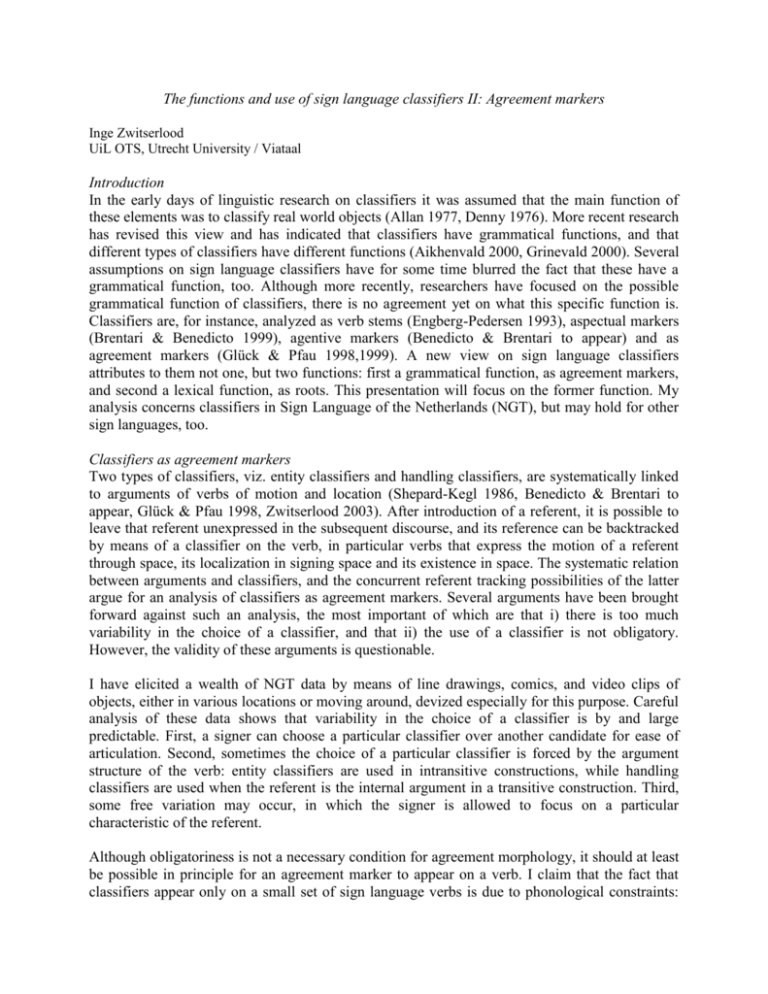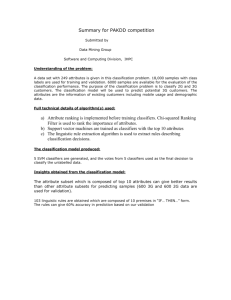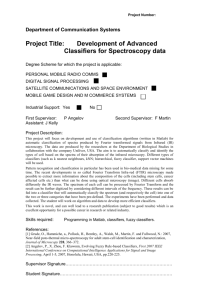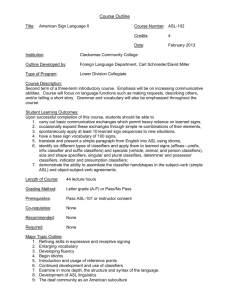The functions and use of sign language classifiers
advertisement

The functions and use of sign language classifiers II: Agreement markers Inge Zwitserlood UiL OTS, Utrecht University / Viataal Introduction In the early days of linguistic research on classifiers it was assumed that the main function of these elements was to classify real world objects (Allan 1977, Denny 1976). More recent research has revised this view and has indicated that classifiers have grammatical functions, and that different types of classifiers have different functions (Aikhenvald 2000, Grinevald 2000). Several assumptions on sign language classifiers have for some time blurred the fact that these have a grammatical function, too. Although more recently, researchers have focused on the possible grammatical function of classifiers, there is no agreement yet on what this specific function is. Classifiers are, for instance, analyzed as verb stems (Engberg-Pedersen 1993), aspectual markers (Brentari & Benedicto 1999), agentive markers (Benedicto & Brentari to appear) and as agreement markers (Glück & Pfau 1998,1999). A new view on sign language classifiers attributes to them not one, but two functions: first a grammatical function, as agreement markers, and second a lexical function, as roots. This presentation will focus on the former function. My analysis concerns classifiers in Sign Language of the Netherlands (NGT), but may hold for other sign languages, too. Classifiers as agreement markers Two types of classifiers, viz. entity classifiers and handling classifiers, are systematically linked to arguments of verbs of motion and location (Shepard-Kegl 1986, Benedicto & Brentari to appear, Glück & Pfau 1998, Zwitserlood 2003). After introduction of a referent, it is possible to leave that referent unexpressed in the subsequent discourse, and its reference can be backtracked by means of a classifier on the verb, in particular verbs that express the motion of a referent through space, its localization in signing space and its existence in space. The systematic relation between arguments and classifiers, and the concurrent referent tracking possibilities of the latter argue for an analysis of classifiers as agreement markers. Several arguments have been brought forward against such an analysis, the most important of which are that i) there is too much variability in the choice of a classifier, and that ii) the use of a classifier is not obligatory. However, the validity of these arguments is questionable. I have elicited a wealth of NGT data by means of line drawings, comics, and video clips of objects, either in various locations or moving around, devized especially for this purpose. Careful analysis of these data shows that variability in the choice of a classifier is by and large predictable. First, a signer can choose a particular classifier over another candidate for ease of articulation. Second, sometimes the choice of a particular classifier is forced by the argument structure of the verb: entity classifiers are used in intransitive constructions, while handling classifiers are used when the referent is the internal argument in a transitive construction. Third, some free variation may occur, in which the signer is allowed to focus on a particular characteristic of the referent. Although obligatoriness is not a necessary condition for agreement morphology, it should at least be possible in principle for an agreement marker to appear on a verb. I claim that the fact that classifiers appear only on a small set of sign language verbs is due to phonological constraints: classifiers cannot appear on verbs that are phonologically specified for a handshape. Since only verbs of motion and location are not underlyingly specified for a handshape, only these verbs allow for the addition of a classifier (handshape). Conclusion It is not uncommon for a linguistic element to have more than one function. I claim that classifiers in sign languages are such multifunctional forms. When they appear on verbs that express the motion through space or the location or existence of a referent in space, they have a grammatical function as agreement markers. In signs other than these verbs, classifiers have another function: roots that, together with one or more other roots (and perhaps affixes) form morphologically headless root compounds. The proposed dual function analysis leads to a better understanding of the characteristics of sign language classifiers and the signs in which they appear and has a larger explanatory power than previous analyses. References Aikhenvald, A.Y. (2000) Classifiers: A Typology of Noun Categorization Devices. Oxford: Oxford University Press. Allan, K. (1977) Classifiers. Language 53, pp. 285-311. Benedicto, E. & D. Brentari (to appear) Where Did All the Arguments Go? Argument-Changing Properties of Classifiers in ASL. Natural Language and Linguistic Theory. Brentari, D. & E. Benedicto (1999) Verbal Classifiers as Heads of Functional Projections: Evidence from American Sign Language. In: Bird, S., A. Carnie, J.D. Haugen & P. Norquest (Eds.), Proceedings of the 18th West Coast Conference on Formal Linguistics. pp. 68-81. Somerville, MA: Cascadilla Press. Denny, J.P. (1976) What's the Use of a Classifier? Proceedings of the 12th Annual Meeting of the Berkeley Linguistics Society 12, pp. 122-32. Engberg-Pedersen, E. (1993) Space in Danish Sign Language: The Semantics and Morphosyntax of the Use of Space in a Visual Language. Hamburg: Signum. Glück, S. & R. Pfau (1998) On Classifying Classification as a Class of Inflection in German Sign Language. In: Cambier-Langeveld, T., A. Lipták & M. Redford (Eds.), Proceedings of Console VI. pp. 59-74. Glück, S. & R. Pfau (1999) A Distributed Morphology Account of Verbal Inflection in German Sign Language. In: Cambier-Langeveld, T., A. Lipták, M. Redford & E.J.v.d. Torre (Eds.), Proceedings of the Seventh Conference of the Student Organization of Linguistics in Europe. pp. 65-80. Leiden: SOLE. Grinevald, C. (2000) A Morphosyntactic Typology of Classifiers. In: Senft, G. (Ed.), Systems of Nominal Classification. pp. 50-92. Cambridge: Cambridge University Press. Shepard-Kegl, J.A. (1985) Locative Relations in American Sign Language Word Formation, Syntax, and Discourse. Massachusetts Institute of Technology, Massachusetts. Zwitserlood, I. (2003) Classifying Hand Configurations in Nederlandse Gebarentaal. Ph.D. Thesis, University Utrecht, Utrecht.






